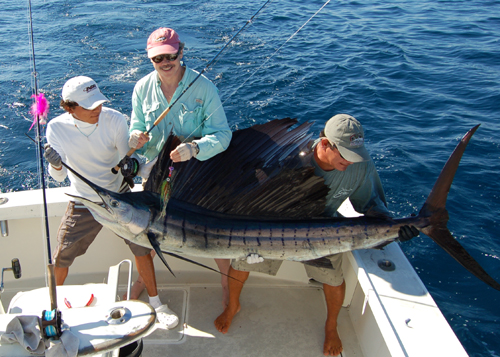
第一次用飛桿釣到旗魚
Soon he was within casting range. "Now!" shouted the skipper, signaling to me to cast the fly.
很快這條魚就游進了垂釣的范圍。“可以啦!”船長喊道,示意我甩桿。
This is the moment where timing is critical. As the sailfish excitedly pursues one of the baits (in this case, a fresh mullet), the crew yanks that bait out of the water, and my task is to cast my fly as close as possible to the spot where the mullet just was, just as the sailfish is looking for the missing mullet.
這時候掌握時機最為重要。因為旗魚正興奮地追逐著釣餌(一條胭脂魚),船員會猛地把餌拖出水面,而我要做的就是趁旗魚正在找跟丟了的魚餌時,盡量把桿甩到剛才胭脂魚所在的位置。
In this case the timing worked like clockwork. The hungry sailfish turned to my fly, decided it was the next best thing to a fresh mullet, and inhaled it. As the 100-lb. fish swam away from the boat, I held tight onto the line and leaned in the opposite direction from the one he was swimming.
這種情況下一定要把握好時機。饑餓的旗魚轉(zhuǎn)向我的假餌,判斷這是不是除了胭脂魚以外最可口的食物,然后就一口把它吞了下去。當(dāng)這條100磅的大魚轉(zhuǎn)身游開的時候,我拉緊了線,使勁兒朝反方向帶。
The sailfish took off like a rocket, leaping clear of the sea in a series of majestic jumps. Line tore off my fishing reel as the fish continued on his blistering initial run. Gradually, his pace slowed and I began to regain line.
旗魚像火箭般躍出了水面,作出一連串精彩的翻騰動作。隨著它不斷地試圖掙脫,線輪也被扯得飛轉(zhuǎn)。慢慢地,旗魚放慢了頻率,我也開始收桿。
Some 20 minutes later, the crew carefully brought the fish aboard for a brief photo opportunity, and then released him again, taking care to ensure he was swimming properly. Off he swam.
20分鐘后,船員小心地把魚撈了起來,讓我快速拍了些照片,就把它放生了,同時確保它還能正常地游動。大魚游走了。











